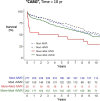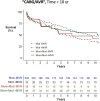Effect of concurrent mitral valve surgery for secondary mitral regurgitation upon mortality after aortic valve replacement or coronary artery bypass surgery
- PMID: 37840960
- PMCID: PMC10570832
- DOI: 10.3389/fcvm.2023.1202174
Effect of concurrent mitral valve surgery for secondary mitral regurgitation upon mortality after aortic valve replacement or coronary artery bypass surgery
Abstract
Objectives: It is uncertain whether concurrent mitral valve repair or replacement for moderate or greater secondary mitral regurgitation at the time of coronary artery bypass graft or aortic valve replacement surgery improves long-term survival.
Methods: Patients undergoing coronary artery bypass graft and/or aortic valve replacement surgery with moderate or greater secondary mitral regurgitation were reviewed. The effect of concurrent mitral valve repair or replacement upon long-term mortality was assessed while accounting for patient and operative characteristics and mitral regurgitation severity.
Results: Of 1,515 patients, 938 underwent coronary artery bypass graft or aortic valve replacement surgery alone and 577 underwent concurrent mitral valve repair or replacement. Concurrent mitral valve repair or replacement did not alter the risk of postoperative mortality for patients with moderate mitral regurgitation (hazard ratio = 0.93; 0.75-1.17) or more-than-moderate mitral regurgitation (hazard ratio = 1.09; 0.74-1.60) in multivariable regression. Patients with more-than-moderate mitral regurgitation undergoing coronary artery bypass graft-only surgery had a survival advantage from concurrent mitral valve repair or replacement in the first two postoperative years (P = 0.028) that did not persist beyond that time. Patients who underwent concurrent mitral valve repair or replacement had a higher rate of later mitral valve operation or reoperation over the five subsequent years (1.9% vs. 0.2%; P = 0.0014) than those who did not.
Conclusions: These observations suggest that mitral valve repair or replacement for more-than-moderate mitral regurgitation at the time of coronary artery bypass grafting may be reasonable in a suitably selected coronary artery bypass graft population but not for aortic valve replacement, with or without coronary artery bypass grafting. Our findings are supportive of 2021 European guidelines that severe secondary mitral regurgitation "should" or be "reasonabl[y]" intervened upon at the time of coronary artery bypass grafting but do not support 2020 American guidelines for performing mitral valve repair or replacement concurrent with aortic valve replacement, with or without coronary artery bypass grafting.
Keywords: aortic valve surgery; coronary artery bypass surgery; guidelines; mitral regurgitation; mitral valve surgery; mortality; outcomes; survival.
© 2023 Asher, Ong, Malapero, Heydarpour, Malzberg, Shahram, Nguyen, Shook, Shernan, Shekar, Kaneko, Citro, Muehlschlegel and Body.
Conflict of interest statement
The authors declare that the research was conducted in the absence of any commercial or financial relationships that could be construed as a potential conflict of interest.
Figures




References
-
- Alghamdi AA, Elmistekawy EM, Singh SK, Latter DA. Is concomitant surgery for moderate functional mitral regurgitation indicated during aortic valve replacement for aortic stenosis? A systematic review and evidence-based recommendations. J Card Surg. (2010) 25:182–7. 10.1111/j.1540-8191.2009.00965.x - DOI - PubMed
-
- Penicka M, Linkova H, Lang O, Fojt R, Kocka V, Vanderheyden M, et al. Predictors of improvement of unrepaired moderate ischemic mitral regurgitation in patients undergoing elective isolated coronary artery bypass graft surgery. Circulation. (2009) 120:1474–81. 10.1161/CIRCULATIONAHA.108.842104 - DOI - PubMed
LinkOut - more resources
Full Text Sources

